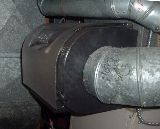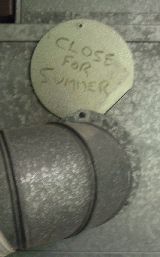|

Drum or evaporator type by-pass humidifier
|
The unit should be checked annually for leaks to prevent rust and/or costly repairs to the blower motor and air handler which are usually located directly below the humidifier.
See rusty blower motor illustration. |
|
.
|
| Furnace Humidifiers
|
|
| ... |
| WARNING. Leaking water trays or a poorly adjusted spray (atomizing type) could rust the heat exchanger of the furnace and lead to costly repairs. |
|
Need more information? Use our search box
The drum or evaporator type by-pass humidifier is the most common type. House air is humidified when it is blown over a water saturated pad, mounted on a rotating drum.
Atomizing humidifier. Unlike the by-pass humidifier there are no pads or filters to replace. Instead, a fine spray is added to the air. However, there is a danger that calcium builds up on the nozzle and the spray becomes a stream or drip that is not picked up by the air. If this happens the furnace will rust out very fast.
|
|
Installation and controls.
The humidifier is installed on the return air duct and is connected with a short duct to the supply duct. The controls are usually installed on the furnace and sometimes on the main floor.
Duct damper. A damper is required if the central air conditioning is attached to the furnace. The damper should be open during the winter and closed during the summer.
Maintenance. When water evaporates, salts and minerals are left behind. The humidifier parts, valve, float, water pan and spray nozzle should be checked and cleaned monthly. The pad should be replaced when it becomes hard and is no longer able to absorb moisture as it is supposed to do. |

Duct damper
|
.
| WARNING. Dirty units become inoperative and a breeding ground for bacteria and mold. When the blower motor kicks in these pollutants will be dispersed throughout the house. |
. |
|
|